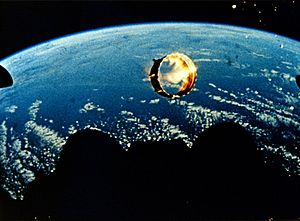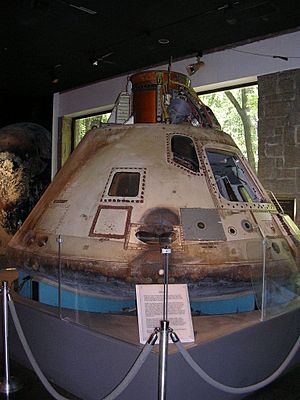Apollo 6 facts for kids

Launch of Apollo 6 filmed from the top of the launch tower
|
|
| Mission type | Test flight |
|---|---|
| Operator | NASA |
| Mission duration | 9 hours 57 minutes 20 seconds |
| Orbits completed | 3 |
| Spacecraft properties | |
| Spacecraft |
Apollo CSM-020
|
| Manufacturer | North American Rockwell |
| Launch mass |
|
| Start of mission | |
| Launch date | April 4, 1968, 12:00:01 UTC |
| Rocket | Saturn V SA-502 |
| Launch site | Kennedy LC-39A |
| End of mission | |
| Recovered by | USS Okinawa |
| Landing date | April 4, 1968, 21:57:21 UTC |
| Landing site | 27°40′N 157°55′W / 27.667°N 157.917°W |
| Orbital parameters | |
| Reference system | Geocentric |
| Regime | Highly elliptical orbit |
| Perigee | 32 kilometers (17 nmi) |
| Apogee | 22,533 kilometers (12,167 nmi) |
| Inclination | 32.6 degrees |
| Period | 389.3 minutes |
| Epoch | April 4, 1968 |
|
|
|
Apollo 6 was a space mission launched on April 4, 1968. It was the second flight in the Apollo program by the United States. It was also the last test flight without astronauts for the powerful Saturn V rocket.
The main goal was to prove that the Saturn V rocket could carry the heavy Apollo spacecraft all the way to the Moon and back. It also needed to show that the Apollo Command Module's heat shield could handle the very fast return into Earth's atmosphere. The mission was planned to last about 10 hours.
However, some problems with the fuel lines in the Saturn V's second and third stage engines kept it from reaching the full speed needed for a Moon trip. Even with these engine issues, the flight still gave NASA enough trust in the Saturn V to use it for missions with people. Since Apollo 4 had already tested the heat shield at full speed, a third unmanned flight was not needed.
Contents
What Apollo 6 Aimed to Do
Apollo 6 had several important goals. It aimed to test the Saturn V rocket's power to send the entire Apollo spacecraft toward the Moon. It also measured how much stress a launch would put on the Lunar Module. The mission also checked the amount of vibration inside the Saturn V when it was almost fully loaded.
The Lunar Module used in this test was a lighter version. It weighed about 26,000 pounds (12,000 kg), which was about 80% of the actual Lunar Module's weight. Also, the Command and Service Module (CSM) was not fully fueled. It weighed 55,420 pounds (25,140 kg) instead of the 63,500 pounds (28,800 kg) needed for a Moon mission.
This mission was the first to use some new facilities at Kennedy Space Center. These included High Bay 3 in the Vehicle Assembly Building (VAB), Mobile Launcher 2, and Firing Room 2.
Building the Rocket
The first part of the Saturn V rocket, called the S-IC, arrived by boat on March 13, 1967. The third stage (S-IVB) and the computer unit also arrived then. The first stage was put together in the Vehicle Assembly Building (VAB) a few days later.
The S-II second stage arrived two months later. Scientists used a special "dumbbell-shaped" spacer to continue testing while waiting for the S-II. This spacer had the same height and weight as the S-II. The actual S-II arrived on May 24 and was added to the rocket on July 7.
Work was slow because they were also getting the Saturn V ready for Apollo 4. Even though the building could hold four Saturn V rockets, there were not enough people or equipment to work on more than one at a time.
The Command and Service Module (CSM) arrived on September 29 and was added on December 10. This CSM was made from two existing spacecraft parts. One part had been damaged in an explosion. The other had been taken apart during the investigation into the Apollo 1 fire. After two months of testing and repairs, the rocket was moved to the launch pad on February 6, 1968.
The Flight of Apollo 6
Launch Day Problems
While Apollo 4 had a perfect launch, Apollo 6 faced problems right from the start. About two minutes into the flight, the rocket began to shake violently. This shaking, called Pogo oscillations, lasted for about 30 seconds. Different parts of the rocket, including the fuel pipes, vibrated like a tuning fork. This caused damage to the part that connected the Command Module and Lunar Module to the Saturn V. Several pieces even broke off during the launch.
After the first stage finished its job, the S-II second stage started having its own issues. One of its five engines had problems about 225 seconds after liftoff. It got worse, and then the engine shut down. Two seconds later, another engine also shut down. The rocket's computer was smart enough to make changes. The remaining engines burned for 58 seconds longer than planned to make up for the lost power. The S-IVB third stage also had to burn for 29 seconds longer than usual.
The S-IC first stage fell back to Earth in the Atlantic Ocean east of Florida. The S-II second stage crashed south of the Azores.
Orbit and Return
Because of the launch problems, the rocket did not reach its planned height. After two orbits, the S-IVB third stage would not restart. Mission control decided to use the Apollo Service Module's engines to push the spacecraft into a higher orbit. This had also been done during Apollo 4.
The Service Module engine fired for 442 seconds. This was longer than it would ever fire on a real Moon mission. This burn helped the spacecraft reach the planned high point of 11,989 nautical miles (22,204 km). However, there was not enough fuel left to speed up the return into Earth's atmosphere. The spacecraft entered the atmosphere at 33,000 feet per second (10,000 m/s) instead of the faster 37,000 feet per second (11,000 m/s) needed for a return from the Moon. Still, this faster speed had already been proven on Apollo 4.
Ten hours after launch, the spacecraft landed 43 nautical miles (80 km) away from its planned landing spot in the North Pacific Ocean, north of Hawaii. It was then picked up by the USS Okinawa.
The S-IVB third stage stayed in orbit for three more weeks. It then fell back into Earth's atmosphere on April 25, 1968.
Even though Apollo 6 did not reach the exact speeds needed for a Moon mission, it was considered successful enough. NASA decided to use the Saturn V for the next mission with astronauts. This mission, Apollo 8, would orbit the Moon instead of just Earth. The next flight, Apollo 7, did not use a Saturn V. It tested a manned Apollo module in Earth orbit.
Why Problems Happened and How They Were Fixed
The shaking during the first stage of the flight was a known issue. It was thought to be fixed, but it happened again. The solution was to add helium gas to the fuel pipes and pumps. This gas acted like a shock absorber. This helped, but it did not completely solve the vibration problem. It even caused engines to shut down later during the Apollo 13 flight.
A fuel pipe carrying liquid hydrogen broke because of the vibrations. This caused two engines in the second stage to stop working. The engines were burning only liquid oxygen, which made them overheat. This led to them shutting down. The problem was fixed by replacing a flexible part of the pipe with a strong loop of stainless steel pipe.
The part connecting the Saturn V and the Apollo modules had a special "honeycomb" structure. This structure expanded because of trapped water and air as the rocket went faster. To fix this, small holes were drilled into the surface. These holes allowed the trapped air and water to escape.
Cameras and Filming
Many documentary movies show a Saturn V launch. One famous clip shows the part between the first and second stages falling away. People often think this is from the Apollo 11 mission. However, it was actually filmed during the Apollo 4 and Apollo 6 flights.
High-speed cameras were dropped from the rocket shortly after the first stage separated. They fell back into the atmosphere and landed in the ocean using parachutes. Only one of the two cameras from the S-II stage on Apollo 6 was found.
Another launch shot often said to be Apollo 11 was also filmed on this day. It shows the rocket lifting off, seen up close and in the center. You can tell it's Apollo 6 because its Apollo module was white. All other Apollo modules were silver.
Public Attention
There was not much news coverage about the Apollo 6 mission. On the same day as the launch, Martin Luther King Jr. was shot and killed in Memphis, Tennessee. Also, President Johnson had announced he would not run for re-election just four days before. These big news events took away attention from the space mission.
Where to See the Capsule
The Apollo 6 Command Module is on display at the Fernbank Science Center in Atlanta, Georgia.
Images for kids
See also
 In Spanish: Apolo 6 para niños
In Spanish: Apolo 6 para niños





